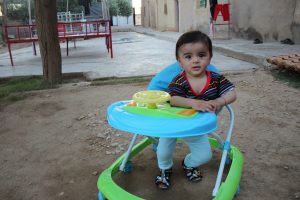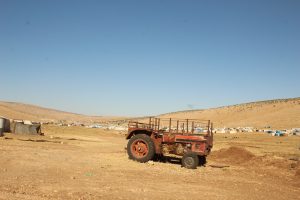Our comrades in England, Plan C, are currently raising money to tackle the severe health crisis among the Êzidî people in Shengal. See here to learn more about their campaign and the struggle of the Êzidî people, and how you can send financial support.
Êzidîs – or Yazidis, as their name is commonly transliterated into English – are an ethno-religious group who mostly live in the Iraqi-Syrian border region. Besides a core population in northern Iraq numbering perhaps 500,000 prior to the rise of ISIS, there are significant Êzidî populations in Syria, Turkey and Armenia and a large diaspora, primarily migrants living in Germany but also across the rest of Europe and Eurasia. Across the world they number less than one million.
They speak the most widely-spoken version of Kurdish, Kurmanci, and culturally they are very close to the Kurdish people. Their religion is monotheistic, and its origins remain the subject of debate, though some scholars link their belief in a redeemed fallen angel named Tawûsê Melek to Islamic Sufi mysticism. It was reported for the first time in the 12th century, but is probably much older.
Êzidxan – or “home of the Yazidis” – typically encompasses two regions in north-western Iraq. One is the region of Shengal, which includes Shengal city, the Sinjar Mountains, and the small towns and villages Sinune, Xana Sor, Borik, Dugure and so on; the other is the Shekhan region which includes Shekhan city, the holy places Lalish and Baadre, and other towns including Hadad. The Shekhan region is currently in the hands of the Kurdistan Regional Government (KRG), while since 2017 the Shengal region has been governing itself autonomously.

As a religious minority, the Êzidîs have been and continue to be victims of many massacres and pogroms. The Êzidîs have suffered no less than 74 such atrocities, which they refer to as ferman – or exterminations. Among these we can count massacres under the Ottoman empire, and the slaughter of 500 Êzidîs in a single co-ordinated bomb attack during the Iraq War.
Throughout this history of annihilation, forced conversion, and assimilation the society has grown closed, traumatized and full of fears. Under Saddam Hussein‘s regime all Êzidîs were forced to leave their homes in small villages in and around the mountains and build houses in the towns and cities. The men started to serve in the state army and police force. Additionally, only Arabic schooling was available and their own culture and values slowly started to seem small and backward.
All in all, the Êzidîs didn‘t have a lot of problems with the federal Iraqi government which took power following Saddam‘s fall, and as such many today believe that the Iraqi nation-state is able to solve their problems. That said, many others are tired of being ruled from Baghdad by Muslim Arabs of any stripe, and want autonomy over their own land and government.
The conquering of Shengal by ISIS was a deep schism in the more recent history of the Êzidîs. In 2014, KRG peshmerga forces stationed in Shengal fled before the advance of ISIS militants from Mosul, where Iraqi forces had already surrended the city without a fight. The capitulation of the peshmerga left society without any protection against the ISIS onslaught.
Uncounted massacres took place. Women and children in particular were kidnapped and, as „non-believers“, treated as property and sold as slaves. Speaking of Yazidi women captured by ISIS, one expert said: “these women have been treated like cattle… They have been subjected to physical and sexual violence, including systematic rape and sex slavery. They’ve been exposed in markets in Mosul and in Raqqa carrying price tags.”

Tens of thousands of people fled into the Sinjar mountains, where they were besieged by ISIS fighters. Hundreds died in the first days, mostly children and elderly people collapsing due to hunger and thirst. After a week, fighters of the PKK freed a corridor through the ISIS lines and rescued around 50,000 civilians.
While the war raged on in Shengal all the civilians fled, often to the KRG, to Rojava or to Europe. A huge refugee camp, Camp Zerdesht, was built in the Sinjar mountains to accommodate displaced people. In early 2017, the last villages in the region were freed from ISIS and around 10 to 20% of the population returned. Still, a lot of people don‘t trust that peace will hold, or generally see any future possibilities for the region.
In August 2017 the autonomy of Shingal was declared and there are still ongoing negotiations with the Iraqi government about the future of the region. Democratic structures are growing as the society tries to find to new strength after the trauma of 2014. Self-defense forces were built up, namely the YBŞ – Yêkitiyên Berxwedana Shengal or Shengal Resistance Units, YJŞ – Yêkitiyên Jinên Shengal or Shengal Women‘s Units and Asayîsha Êzidxan or Yezidi‘s Homeland Security.
In autumn 2017 the Iraqi government‘s Heshd-el-shabî militia came into Shingal. Once again the KRG‘s peshmerga forces ran away, in the same moment destroying any lingering trust the people had in them.

In April 2018, the PKK‘s guerrilla forces retreated from Shengal after Turkey threatened to attack the region in pursuit of PKK, knowing that after the upbuilding of YBSH/YJSH the society was once again able to protect itself.
At the same time, the Iraqi army returned to Shengal. The people no longer expect Turkey to strike, but nor do they trust an almost exclusively Muslim army to protect them in the case of another Islamist assault.
Much remains unclear. With at least four different armed groups – the Iraqi Army, Heshd-el-shabî, Heyder Shesho‘s KRG-linked HPÊ militia and YBŞ/YJŞ – all mixed up in this small region, there is always trouble boiling up.
In the middle of this uneasy calm, it is women who face the worst crisis. Shengal was already a deeply patriarchal society, where women typically married young, had children young, and were thereafter confined to unpaid reproduction labour in the home. Formal, political and sexual education were all absent from most women‘s lives. The disappearances, sexual abuse, enslavement and murder they suffered under Daesh must be understood in this context.
Over the next week we‘ll be sharing a number of interviews with women in the Shengal region: a mother whose children are still in the hands of ISIS, a young women who escaped their clutches after years of enslavement, a member of the Internationalist Commune working in the women’s and youth structures to build up civil society anew in the ravaged Shengal region.
This crisis was caused by male politicians’ imperialist meddling in the Middle East, and carried out by men, acting under the influence of warped and misogynistic religious hatred. It is only by listening to the voices of women that we can understand how to build up a society where such atrocities never happen again.